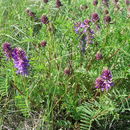Comprehensive Description
(
Inglês
)
fornecido por North American Flora
Diholcos micranthus Rydb. Fl. Rocky Mts. 500. 1917
A perennial, with a woody root; stems several, erect or ascending, sparingly strigose, 2-4 dm. high; leaves 5-7 cm. long; stipules deltoid, 4 mm. long; leaflets 17-25, linear to lanceoblong, acute at each end, 7-20 mm. long, 2-4 mm. wide, glabrous above, strigose beneath; peduncles 5-7 cm. long; racemes many-flowered, 5-7 cm. long; bracts lance-subulate, 4 mm. long; pedicels 2-3 mm. long, recurved; calyx strigose, the tube 2-2.5 mm. long, the teeth subulate-filiform, 1-1.5 mm. long, the upper shorter; corolla 6-7 mm. long, cream-colored; pod strigose, the stipe 3-4 mm. long, the body about 8 mm. long, acute at each end, scarcely 2 mm. wide and 3 mm. thick; seeds obliquely reniform, 3 mm. long, dark-brown.
Type locality: [La Veta.J Colorado. Distribution: Colorado.
- citação bibliográfica
- Per Axel Rydberg. 1919. (ROSALES); FABACEAE; PSORALEAE. North American flora. vol 24(1). New York Botanical Garden, New York, NY
Comprehensive Description
(
Inglês
)
fornecido por North American Flora
Diholcos bisulcatus (Hook.) Rydb. Bull. Torrey Club
32:664. 1906.
Phaca hisulcala Hook. Fl. Bor. Am. 1: 145. 1831.
Astragalus bisulcatus A. Gray, Pacif. R. R. Rep. 12: 42. 1860.
Tragacantha bisulcata Kuntze. Rev. Gen. 943. 1891.
Astragalus bisulcatus hedysarifomis Gand. Bull. Soc. Bot. Fr. 48: xiv. 1902.
A perennial, with a thick woody root; stems several from the short caudex, 3-10 dm. high sulcate, more or less strigose; leaves ascending, 6-10 cm. long; stipules deltoid, acute or acuminate, 4-6 mm. long; leaflets 15-25, oblong to oval, 1-2.5 cm. long, 3-10 mm. wide, firm; peduncles 7-15 cm. long; racemes many-flowered, 5-10 cm. long; bracts lance-subulate, 4-6 mm. long; flowers drooping; pedicels 2-3 mm. long; calyx strigose, the tube about 4 mm. long and 3 mm. broad, the teeth subulate, 2-3 mm. long; corolla purple or rarely white, 12-15 mm. long; banner obovate, moderately arched at the middle; wings nearly as long, the blade oblong, with a long, recurved auricle; keel-petals a little shorter, the blade broadly obliquely lunate, more curved towards the rounded apex, with a rather large auricle; pod strigose, the stipe 3-4 mm. long, the body 12-15 mm. long; seeds dark-brown or black, reniform, 4 mm. long, 2 mm. wide.
Type locality: Plains of the Saskatchewan, Canada.
Distribution: Manitoba to Nebraska. Colorado, Idaho, and Alberta.
- citação bibliográfica
- Per Axel Rydberg. 1919. (ROSALES); FABACEAE; PSORALEAE. North American flora. vol 24(1). New York Botanical Garden, New York, NY
Physical Description
(
Inglês
)
fornecido por USDA PLANTS text
Perennial, Herbs, Stems woody below, or from woody crown or caudex, Taproot present, Nodules present, Stems erect or ascending, Stems less than 1 m tall, Stems solid, Stems or young twigs sparsely to densely hairy, Leaves alternate, Leaves petiolate, Stipules conspicuous, Stipules membranous or chartaceous, Stipules persistent, Stipules connate to each other, forming a tuber or sheath, Leaves compound, Leaves odd pinnate, Leaf or leaflet margins entire, Leaflets opposite, Leaflets 10-many, Leaves hairy on one or both surfaces, Inflorescences racemes, Inflorescence axillary, Bracts very small, absent or caducous, Flowers zygomorphic, Calyx 5-lobed, Calyx gibbous, inflated, or spurred, Calyx glabrous, Petals separate, Corolla papilionaceous, Petals clawed, Petals white, Petals blue, lavander to purple, or violet, Banner petal narrow or oblanceolate, Wing petals narrow, oblanceolate to oblong, Wing tips obtuse or rounded, Keel petals auriculate, spurred, or gibbous, Keel tips obtuse or rounded, not beaked, Stamens 9-10, Stamen s diadelphous, 9 united, 1 free, Filaments glabrous, Style terete, Style persistent in fruit, Fruit a legume, Fruit stipitate, Fruit unilocular, Fruit tardily or weakly dehiscent, Fruit oblong or ellipsoidal, Fruit rugose wrinkled or reticulate, Fruit coriaceous or becoming woody, Fruit exserted from calyx, Fruit beaked, Fruit glabrous or glabrate, Fruit hairy, Fruit 3-10 seeded, Fruit 11-many seeded, Seeds cordiform, mit-shaped, notched at one end, Seed surface smooth, Seeds olive, brown, or black.
Astragalus bisulcatus
(
Inglês
)
fornecido por wikipedia EN
Astragalus bisulcatus, commonly called two-grooved milkvetch or silver-leafed milkvetch, is a leafy perennial with pea-like flowers. It is native to central and western North America,[1] and typically grows on selenium-rich soils. It accumulates selenium within its tissues, and when livestock consume it, the selenium can be toxic.[2]
Description
Astragalus bisulcatus is a herbaceous perennial with a thick woody root-stock, growing 30 to 100 cm tall.[3] It has numerous simple stems and long pinnate leaves. The flowers are produced in narrow elongated racemes. The flowers are white or purple in color[4] and bloom in late spring and early summer. The seed pods characteristically are two grooved on the upper surface. The fruits ripen and release their seeds in July and August.[5] The seeds are dark brown or black, reniform in shape, 4 mm long and 2 mm wide.[3][6]
Selenium toxicity
Astragalus bisulcatus accumulates large quantities of selenium when grown on soils that have selenium, the plant produces amino acids where sulfur is replaced by selenium.[7] Most animals avoid Astragalus bisulcatus because of the musky odor of the dimethyl selenium compounds contained in the plants tissues.[8] Yet, sheep and cattle have indulged in eating the plant, becoming victims of selenium toxicity. Sheep can die in thirty minutes from eating a half a pound of Astragalus bisulcatus, and in 1907 and 1908, approximately 15,000 sheep in Wyoming died with symptoms of either alkali disease or the blind staggers; both of which were outcomes of digesting a large amount of selenium from Astragalus bisulcatus.[9]
References

- licença
- cc-by-sa-3.0
- direitos autorais
- Wikipedia authors and editors
Astragalus bisulcatus: Brief Summary
(
Inglês
)
fornecido por wikipedia EN
Astragalus bisulcatus, commonly called two-grooved milkvetch or silver-leafed milkvetch, is a leafy perennial with pea-like flowers. It is native to central and western North America, and typically grows on selenium-rich soils. It accumulates selenium within its tissues, and when livestock consume it, the selenium can be toxic.
- licença
- cc-by-sa-3.0
- direitos autorais
- Wikipedia authors and editors

